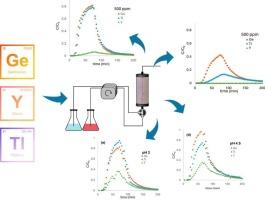铊、锗和钇在断裂白云岩中的传输
IF 8
1区 环境科学与生态学
Q1 ENVIRONMENTAL SCIENCES
引用次数: 0
摘要
铊(Tl)、锗(Ge)和钇(Y)是天然存在的元素,由于它们在工业和技术应用中的使用越来越多,已经成为日益关注的污染物。由于它们的广泛应用,这些元素可能进入环境,在那里它们可能迁移到含水层,对地下水质量构成风险,并可能影响人类和环境健康。本研究考察了这些元素在断裂白云岩中的运移动力学,考虑了pH、盐度和岩石化学成分对运移机制的影响。采用Bonneterre白云岩和志留系白云岩两种断裂白云岩岩心进行柱状实验,探讨了不同溶液条件下Tl、Ge和Y的输运规律。在不同的pH和盐度水平下进行了实验,以评估它们对元素迁移率的影响。尽管这些元素的输运行为迄今为止受到的关注有限,但本文的结果表明,岩石基质与裂缝中的优先流动一起,在影响溶质输运机制方面起着关键作用。该研究进一步强调了白云石的化学成分以及溶液的pH和盐度对这些污染物的迁移性有显著影响。例如,在pH 7和50 ppm盐度下,志留系白云岩的Ge、Tl和Y的总平均回收率分别为~ 100%、~ 100%和~ 20%,而在Bonneterre白云岩中,Ge、Tl和Y的平均回收率分别为~ 60%、25%和0%。这些因素对运移动力学有很大影响,这表明在理解污染物迁移时必须考虑岩石性质和溶液条件。本文章由计算机程序翻译,如有差异,请以英文原文为准。

Transport of thallium, germanium, and yttrium through fractured dolomite
Thallium (Tl), germanium (Ge), and yttrium (Y) are naturally occurring elements that have become contaminants of emerging concern due to their increasing use in industrial and technological applications. As a result of their widespread application, these elements can enter the environment, where they may migrate into aquifers, posing risks to groundwater quality and potentially impacting human and environmental health. This study investigates the transport dynamics of these elements through fractured dolomite rocks, considering the effects of pH, salinity, and rock chemical composition on transport mechanisms. Two types of fractured dolomite cores, Bonneterre dolomite, and Silurian dolomite, were used in column experiments to explore the transport of Tl, Ge, and Y under varying solution conditions. The experiments were conducted with different pH and salinity levels to assess their impact on element mobility. Although the transport behavior of these elements has received limited attention to date, the results presented here demonstrate that the rock matrix plays a critical role, alongside preferential flow in fractures, in influencing solute transport mechanisms. The study further highlights that the chemical composition of dolomite, as well as solution pH and salinity, significantly affect the mobility of these contaminants. For example, Ge, Tl and Y at pH 7 and 50 ppm salinity showed ∼100%, ∼100% and ∼ 20% total mean recovery, respectively, in Silurian dolomite, compared to ∼60%, <25% and 0% recovery, respectively, in Bonneterre dolomite. These factors are shown to strongly influence transport dynamics, suggesting that both the rock properties and solution conditions must be considered in understanding contaminant mobility.
求助全文
通过发布文献求助,成功后即可免费获取论文全文。
去求助
来源期刊

Science of the Total Environment
环境科学-环境科学
CiteScore
17.60
自引率
10.20%
发文量
8726
审稿时长
2.4 months
期刊介绍:
The Science of the Total Environment is an international journal dedicated to scientific research on the environment and its interaction with humanity. It covers a wide range of disciplines and seeks to publish innovative, hypothesis-driven, and impactful research that explores the entire environment, including the atmosphere, lithosphere, hydrosphere, biosphere, and anthroposphere.
The journal's updated Aims & Scope emphasizes the importance of interdisciplinary environmental research with broad impact. Priority is given to studies that advance fundamental understanding and explore the interconnectedness of multiple environmental spheres. Field studies are preferred, while laboratory experiments must demonstrate significant methodological advancements or mechanistic insights with direct relevance to the environment.
 求助内容:
求助内容: 应助结果提醒方式:
应助结果提醒方式:


